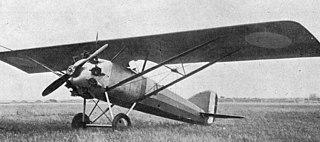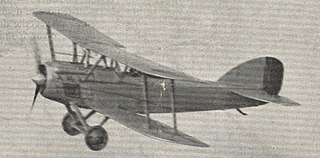
The Blériot 127 was a monoplane bomber aircraft developed and produced by the French aircraft manufacturer Blériot.

The Gourdou-Leseurre GL.30 was a racing aircraft built in France in 1920 which formed the basis for a highly successful family of fighter aircraft based on the same design.
The Bernard SIMB V.1 was a French single seat racing monoplane designed to compete for the 1924 Beaumont Cup. It crashed on its first flight and was not rebuilt.
The Bernard SIMB AB 10 was a French single-engine, single-seat, highly streamlined, cantilever, all-metal low-wing monoplane of advanced design. It first flew in 1924 but was not ordered into production.

The Bernard SIMB AB 12 was a French single engine, single-seat monoplane fighter aircraft built in the 1920s. Though advanced for its time, it failed to gain a production order and only one was built.
The Bernard 80 GR was one of three types built by different French constructors in response to a government call for an aircraft capable of setting new long-distance records. A single engine monoplane with a crew of two, the 80 GR set an absolute record for flight over a closed circuit in April 1931, covering 8,960 km (5,569 mi). Modifications led to a new designation as the Bernard 81 GR but no more records were set despite several attempts.
The Bernard H 110 was a single engine, single seat monoplane floatplane fighter designed for a French Navy competition. It flew in 1935 but had only made four test flights when the Bernard company was declared bankrupt, preventing further development.
The Bernard 260 C1 was a French all-metal, single-engine, low-wing monoplane with an open cockpit and fixed undercarriage, designed to a government single-seat fighter specification issued in 1930. After extensive comparative tests the Dewoitine D.500 was ordered in preference, though the performances of the two aircraft were similar.

The Nieuport-Delage NiD 48 was a French single-engine parasol wing light fighter aircraft, designed and built in the 1920s. Its performance was not markedly better than that of the much heavier Nieuport-Delage NiD 62 then going into production, so only two were flown.

The Wibault 13C.1 Trombe (Whirlwind), later known as the Wib 130C.1 Trombe was a single seat, parasol wing lightweight fighter aircraft designed and built in France in the 1920s. It was developed into the more powerful Wib 170C.1 Tornade (Tornado) but government interest in lightweight fighters soon waned.

The Wibault Wib 210 C.1 was a single engine, single seat low wing monoplane fighter aircraft, designed and built in France in the late 1920s. Flight tests revealed vibration problems and development was quickly abandoned.

The Letov Š-14 was a single-seat, single-engine aircraft, designed and built in Czechoslovakia in the early 1920s. Originally intended as a biplane fighter, it was later modified into a monoplane and entered as a contestant in a speed competition.

The Hanriot H.26 was a French single seat fighter aircraft prototype completed in 1923. Only one was built.

The Blériot-SPAD S.91 was a French light-weight fighter aircraft. It would be later developed into the Blériot-SPAD S.510, the last biplane produced by the French aeronautic industries.

The Potez 31 was a prototype French two-seat night fighter, flown in about 1928, intended to fill the Cn.2 specification for the Armee de l'Air. Only one was built.
The de Marçay 4 was a single seat monoplane fighter built in France in 1923 for a government competition. It did not receive a production contract.

The Les Mureaux 3 C.2 and Les Mureaux 4 C.2 were French two seat, parasol winged fighters, flown in 1927-8, which differed only in their engines. They were developed into near identical army co-operation types, the ANF Les Mureaux 130 A.2 and ANF Les Mureaux 131 A.2, in 1929–31.

The Astra-Protopopescu or Astra-Proto was a Romanian reconnaissance aircraft flown and tested in 1925.
The unsuccessful French Farman F.200 of 1923 shared its type name with the 1929 Farman F.200, the progenitor of a series of parasol wing tourers. It was a two-seat touring aircraft, with a low, thick, cantilever wing. Only one was built and only briefly tested.
This aircraft, Messier's only aircraft and unnamed, was a one-off built to show the advantage of undercarriage retraction and the practicality of a bicycle wheel arrangement.












